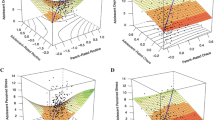Abstract
Examination of boundary regulation can provide family therapists with a framework to describe both the functioning of family systems and personal systems (i.e., the intrapsychic functioning of individual family members). In the present study, late adolescents' perceptions of boundary regulation within their family systems (i.e., ratings of family health, communication, leadership, expressiveness, cohesion, and family conflict) were related to regulation of their personal boundaries (i.e., self-reported personal competence, distress, and patterns of defense mechanism use). In addition, personal system variables reliably discriminated between adolescents who described their families as psychologically healthy versus psychologically unhealthy.
Similar content being viewed by others
References
Aronoff, J., Stollak, G. E., & Woike, B. A. (1994). Affect regulation and the breadth of interpersonal engagement.Journal of Personality and Social Psychology, 67, 105–114.
Beavers, W. R., & Hampson, R. B. (1990).Successful families: Assessment and intervention. New York: Norton.
Block, J. H., & Block, J. (1980a). The role of ego-control and ego-resiliency in the organization of behavior. In W. A. Collins (Ed.),Minnesota symposia on child psychology (Vol. 13, pp. 39–101). Hillsdale, NJ: Erlbaum.
Block, J. H., & Block, J. (1980b).The California child Q-set. Palo Alto, CA: Consulting Psychologists Press.
Burt, C. E., Cohen, L. H., & Bjorck, J. P. (1988). Perceived family environment as a moderator of young adolescents' life stress adjustment.American Journal of Community Psychology, 16, 101–122.
Cramer, P. (1991).The development of defense mechanisms. New York: Springer-Verlag.
Enos, D. M., & Handal, P. J. (1986). The relation of parental marital status and perceived family conflict to adjustment in white adolescents.Journal of Consulting and Clinical Psychology, 54, 820–824.
Frank, S. J., Pirsch, L. A., & Wright, V. C. (1990). Late adolescents' perceptions of their relationships with their parents: Relationships among deidealization, autonomy, relatedness, and insecurity and implications for adolescent adjustment and ego identity status.Journal of Youth and Adolescence, 19, 571–588.
Grossman, F. K., Beinashowitz, J., Anderson, L., Sakurai, M., Finnin, L., & Flaherty, M. (1992). Risk and resilience in young adolescents.Journal of Youth and Adolescence, 21, 529–550.
Ihilevich, D., & Gleser, G. C. (1986).Defense mechanisms. Owosso, MI: DMI Associates.
Kleinman, S. L., Handal, P. H., Enos, D., Searight, H. R., & Ross, M. J. (1989). Relationship between perceived family climate and adolescent adjustment.Journal of Clinical Child Psychology, 18, 351–359.
Kobak, R. R., & Sceery, A. (1988). Attachment in late adolescence: Working models, affect regulation, and representations of self and others.Child Development, 59, 135–146.
Kurdek, L. A., & Sinclair, R. J. (1988). Adjustment of young adolescents in two-parent nuclear, stepfather, and mother-custody families.Journal of Consulting and Clinical Psychology, 56, 91–96.
Lamborn, S. D., Mounts, N. S., Steinberg, L., & Dornbusch, S. M. (1991). Patterns of competence and adjustment among adolescents from authoritative, authoritarian, indulgent, and neglectful families.Child Development, 62, 1049–1065.
Melito, R. (1988). Combining individual psychodynamics with structural family therapy.Journal of Marital and Family Therapy, 14, 29–43.
Minuchin, S. (1974).Families and family therapy. Cambridge, MA: Harvard University Press.
Raja, S. N., McGee, R., & Stanton, W. R. (1992). Perceived attachments to parents and peers and psychological well-being in adolescence.Journal of Youth and Adolescence, 21, 471–485.
Stewart, E. R., McKenry, P. C., Rudd, N. M., & Gavazzi, S. M. (1994). Family processes as mediators of depressive symptomatology among rural adolescents.Family Relations, 43, 38–45.
Vaillant, G. E., Bond, M., & Vaillant, C. O. (1986). An empirically validated hierarchy of defense mechanisms.Archives of General Psychiatry, 43, 786–794.
Woike, B. A., Aronoff, J., Stollak, G. E., & Loraas, J. A. (1994). Links between intrapsychic and interpersonal defenses in dyadic interaction.Journal of Research in Personality, 28, 101–113.
Wood, B., & Talmon, M. (1983). Family boundaries in transition: A search for alternatives.Family Process, 22, 347–357.
Author information
Authors and Affiliations
Rights and permissions
About this article
Cite this article
Meyers, S.A., Stollak, G.E., Aronoff, J. et al. Boundary regulation in family and personal systems: Perceptions of late adolescents. Contemp Fam Ther 18, 279–290 (1996). https://doi.org/10.1007/BF02196728
Issue Date:
DOI: https://doi.org/10.1007/BF02196728




